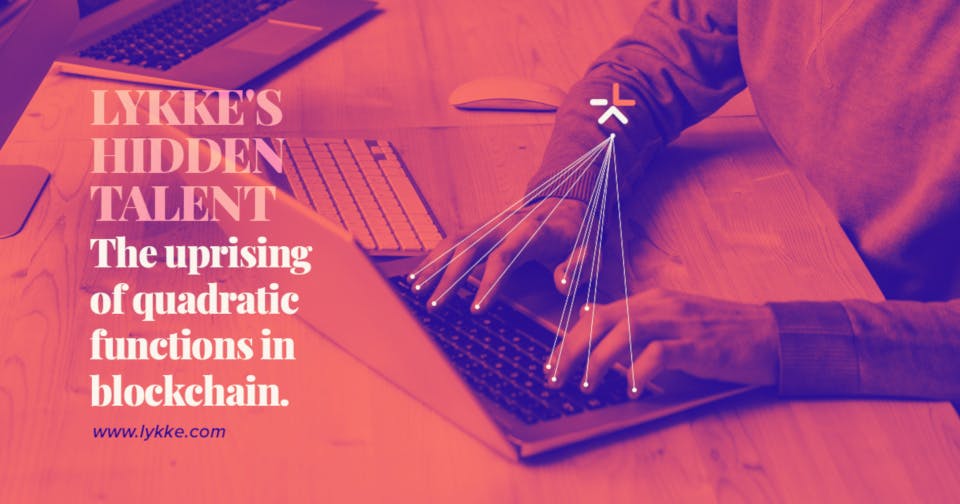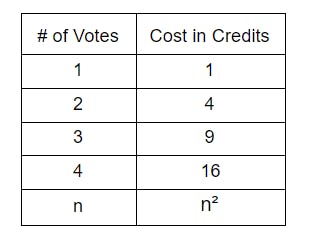Lykke's Hidden Talent Episode 01

- Date
- 13/05/2021
- Written by
- Lykke
- Share
- Leave your opinion (0 reviews)
The uprising of quadratic functions in blockchain
Blockchain quadratic development promises to bring fresh blood to some of the old problems society faces.
Apparently, we live in a democracy where we all have equal rights and express our will through democratic processes. However, our society is set up in a way where individuals with more concentrated power “weigh” moreover the ones with less power in any sort of a decision making process. The most common cases are government elections and legislations influenced by industries, such as the Oil and Pharmaceutical industries. So here comes the doubt: does the will of the common man on the street weigh anything against the accumulated power? Is democracy still a thing? Or is it just a utopian dream still lingering from the times of Ancient Greek philosophy?
How can we avoid this concentration of power in the hands of a few? It may seem a rhetoric question, but probably not any more... Welcome Quadratic Voting.
Quadratic Voting is a system where each individual is given an equal amount of non-transferable credits. These credits act as a budget to make decisions, where each individual can express the degree of preference based on the number of credits they spend on a vote. Holding a stronger preference will become progressively expensive and in consequence depleting your budget of credits, leaving low or no credits to spend on other decisions.
In other words, it is cheaper to have little influence on many issues but is expensive to have a lot of influence on one issue. Voters will have to prioritize their needs and intentions, they can choose to use a single vote in all issues, or they can exercise their right to apply the degree of preference to the cost of their credits.
Example:
Company "X" is about to hold a board member meeting to decide on the budget allocation for the next year. The board consists of 3 members, Alice, Lucy, and Bob. The areas to allocate fundings are Marketing, Development, User Experience, and Legal. Each one of the board members will receive 4 credits, the board members can choose to spend their credits on the areas they believe would be key to grow next year.
In this example, Bob and Lucy applied their degree of preference by voting on the areas they believed the company needed to grow. Whereas Alice, played it safe allocating one single vote on all areas. In this example, Marketing and Development will receive 37.5% each of the allocation budget, and User Experience and Legal will receive 12.5% each.
This way people get a powerful tool to express their will the way they want: voting for the issues they consider more important and giving those issues a stronger preference.
A cousin of Quadratic Voting is Quadratic Funding. Quadratic funding emerged as a derivative product of Quadratic Voting thanks to Glen Weyl and Vitalik Buterin. These two exceptional individuals came up with a new theory to fund public goods. From Investopedia, "A public good is a product that an individual can consume without reducing its availability to others and of which no one is deprived." Classic examples are law enforcement, national security, street light, environment, etc..
However, the tragedy of the commons highlights the intrinsic problem of public goods, where all individuals benefit from but no individual is willing to contribute. It is hard to find individuals willing to contribute to public goods, if they contribute they only get a small part of the benefit in contrast to the cost of their contribution.
How does it work?
If Alice gives 1 Euro to Bob, Bob will receive 1 Euro. But if Bob, Alice, Lucy, and multiple people donate anonymously and not in exchange for any kind of service to an entity. The quadratic funding applies, the amount in euro received by that entity is greater than the amount sent to that entity.
The formula is quite simple, you take the square root of all the sent amounts, then you add them all by the square of the sum.
The government or organizing entity is required to allocate a grant to match the individual contributions.
Example:
Alice donates 100 euros to research on climate change, at the same time, Bob and Lucy send 250 and 300 euros respectively on the same research. The research instead of receiving 650 euros, thanks to the quadratic funding grant they receive 1.860,35 euros.
In this example, Alice, Lucy and Bob sent a total amount of 650 euros, the grant matched the transfer with 1.213,35 euros. With this model every little donation towards a popular cause has the potential of becoming a large donation, motivating people to donate more often thinking that their donation might have an impact.
For the majority of us blockchain technology stopped being a novelty, but we are still amazed by the ramifications when blockchain technology combines with different fields.
For example, here at Lykke we offer unique services for cryptocurrency portfolio management, such as the LyCI index tokens. It’s a two-face combination of a crypto index and a utility token tied to it. By purchasing the utility, the user gets access to all the constituents of the index that get automatically rebalanced and restructured. Learn more about its architecture on our website.
About Lykke’s Hidden Talent
Lykke’s Hidden Talent is a project which aims to showcase the hidden talent within Lykke Corp. Aside from the daily work our team does, as individuals, each one of us has different ideas or talents that might go unnoticed. This series acts as a platform to showcase these amazing ideas and talents. Please follow, share, like, and enjoy!

